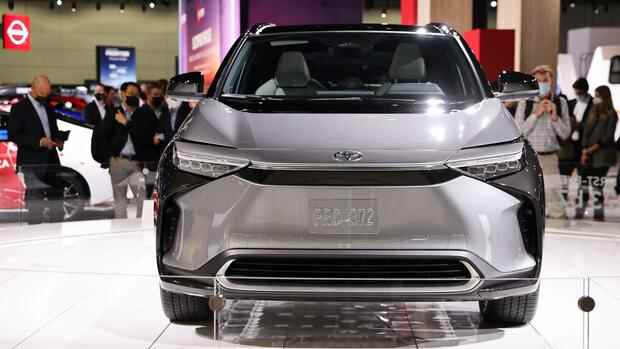Brussels The world’s largest automaker took a long time: next year Toyota will start selling its first real electric car, including in Europe. The bZ4X should be available from dealers in the first half of the year. After that there will be other models with a purely electric drive. European boss Matt Harrison is also preparing electrical production in Toyota’s European plants.
Volkswagen and the Korean Hyundai Group decided to switch to electric drive much earlier. Toyota, however, hesitated and is therefore about two years behind. The trigger for this was the comparatively broad hybrid range that the Japanese car company has in its model portfolio. For more than 20 years, for example, Toyota has been selling its Prius, with which the Japanese ventured into partial electrification.
But meanwhile the trend towards pure electric cars can no longer be stopped, Toyota cannot escape the pressure in its most important export markets. In Europe, China and the USA, governments are pressing for rapid electrification and CO2 reduction. Only in Toyota’s Japanese home market is progress with electric vehicles a little slower.
“All-electric cars are part of our comprehensive vehicle strategy in order to achieve complete climate neutrality in the next few years,” said European boss Harrison in Brussels. Volkswagen has introduced the electric ID range, and Toyota customers will have to get used to the term “bZ” (abbreviation for beyond Zero).
Top jobs of the day
Find the best jobs now and
be notified by email.
Toyota is pretty much based on the Volkswagen model when it comes to the type designation of its new electric cars. “BZ” becomes the basic name, depending on the size, it is then numbered accordingly. An X stands for the additional all-wheel drive. The bZ4X, the first all-electric car from the Japanese, is to become a direct competitor of the ID.4 from Volkswagen, Toyota managers frankly admit. Both cars are about the same size, like the German competitor, the model from Japan is also an SUV.
Model Volkswagen
Smaller electric cars from Toyota get a smaller number in the type designation, just like Volkswagen does. The larger the number, the larger the electric vehicles. There should be a total of seven purely electrically powered bZ models by 2025. The term “beyond zero” (more than zero) is a promise: Toyota not only wants to reduce CO2 emissions to zero, but wants to do everything it can to protect the climate and the environment.
Toyota only wants to comment on further model planning to a very limited extent. “For the European market, we are particularly thinking about smaller models,” explains Harrison, “and they will come soon.” So, intensive work on a bZ2 or bZ3 should already be carried out.
In 2025, Toyota Europe plans to have a sales share of around ten percent for all-electric cars. The most important competitor, Volkswagen, is likely to be more than double that. Toyota sees no competitive disadvantage in this, but is deliberately launching a somewhat cautious ramp-up in the production and sale of pure electric cars.
“Hybrids will play an important role for a long time to come,” added Gerald Killmann, Head of Development at Toyota Europe. The Japanese car company sees the purely electric cars as an addition to its existing model range, which already includes a whole range of hybrids and also a few hydrogen-powered cars.
Toyota calculates that batteries for electric cars will still be scarce and therefore expensive for a certain time. That is why the Japanese group would rather distribute the few battery cells available to a larger number of hybrids because the batteries there are much smaller. If such hybrid models are then mainly used on shorter routes, climate neutrality can still be achieved, says Toyota. “At least in Western Europe we will achieve this goal by 2035,” emphasized Matt Harrison. The prerequisite, however, is that the charging infrastructure grows with it.
Alternative hydrogen
In contrast to most other car manufacturers, Toyota continues to rely on the use of hydrogen, either in the fuel cell or directly in a converted internal combustion engine. “The hydrogen infrastructure in Europe is growing,” said the Toyota manager. The automaker sees the most important areas of application in trucks, buses, planes and ships. But Toyota also believes in hydrogen when it comes to passenger cars, which is why it has a fuel cell car in its range. However, by the end of October, the Japanese car company had only sold 609 copies of the Mirai model in Europe.
The new electric cars from the “bZ” series will initially be exported from Japan to Europe. Later, probably after 2025, electric vehicles will also be manufactured in Toyota plants in Europe. “Of course we need electrical production in Europe,” Harrison confirmed in an interview with the Handelsblatt. This also includes European production of battery cells. Toyota has not yet decided whether the battery cells will be produced in-house or purchased from suppliers.
Despite the delay in all-electric models, the Toyota strategy is met with approval in the financial markets. “Toyota is catching up with electric cars,” emphasizes Kohei Takahashi, automotive analyst at the major Swiss bank UBS. In the USA, China and Europe, strong demand for the new electric cars from the Japanese group can be expected. Toyota’s high cost discipline ensures that returns remain high even with a mix of purely electric cars, hybrids and hydrogen models, adds Takaki Nakanishi from the US investment house Jefferies.
Toyota has weathered the current chip crisis comparatively well in Europe. The Japanese manufacturer plans to sell 1.07 million vehicles (cars and vans) on the European car market this year, an increase of around eight percent. There should be 1.3 million copies in 2022, and there should be enough semiconductors for that. “The situation is now stable,” said European boss Harrison.
More: On the way to a circular economy: This is how the car companies want to become sustainable.
